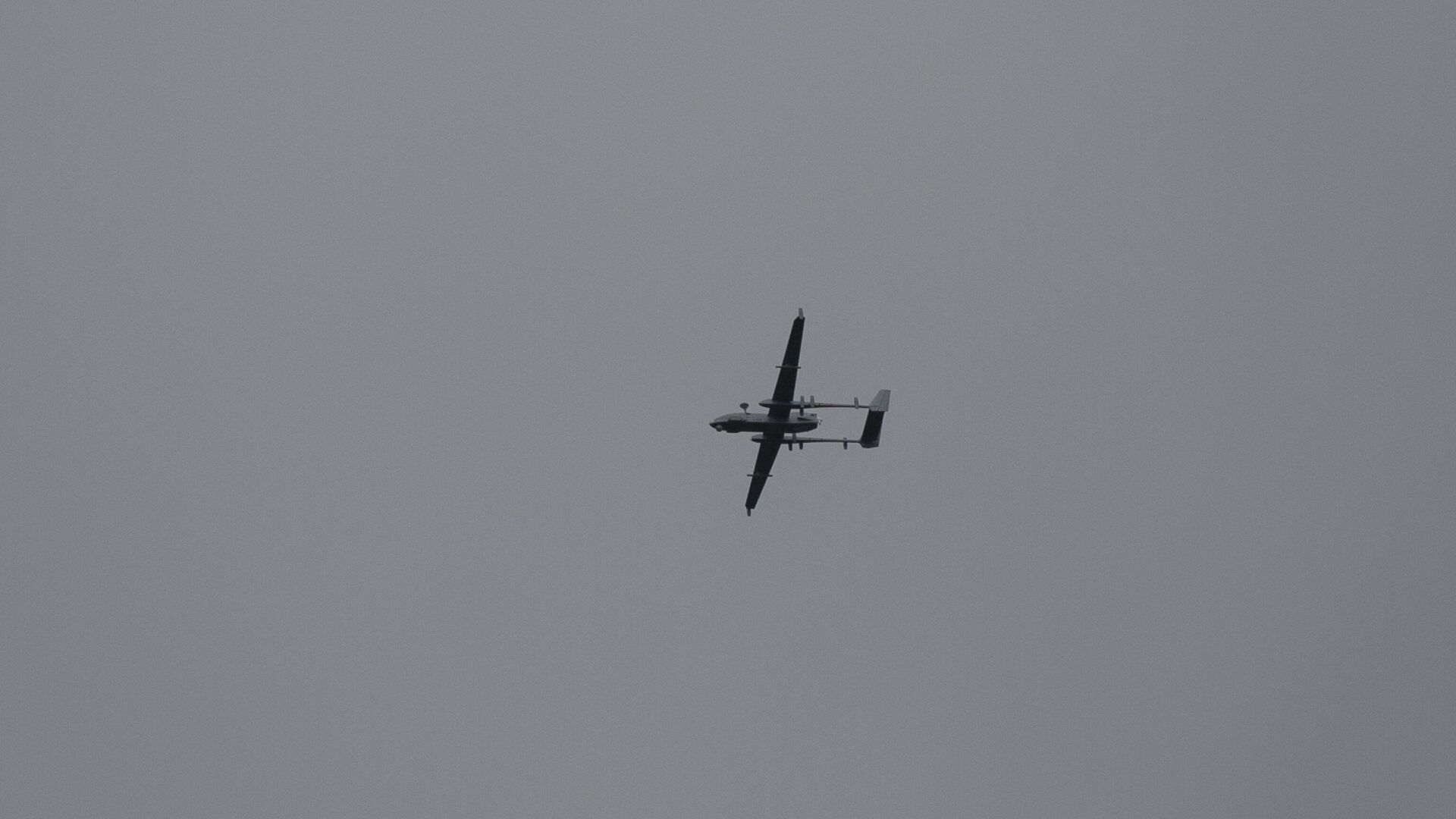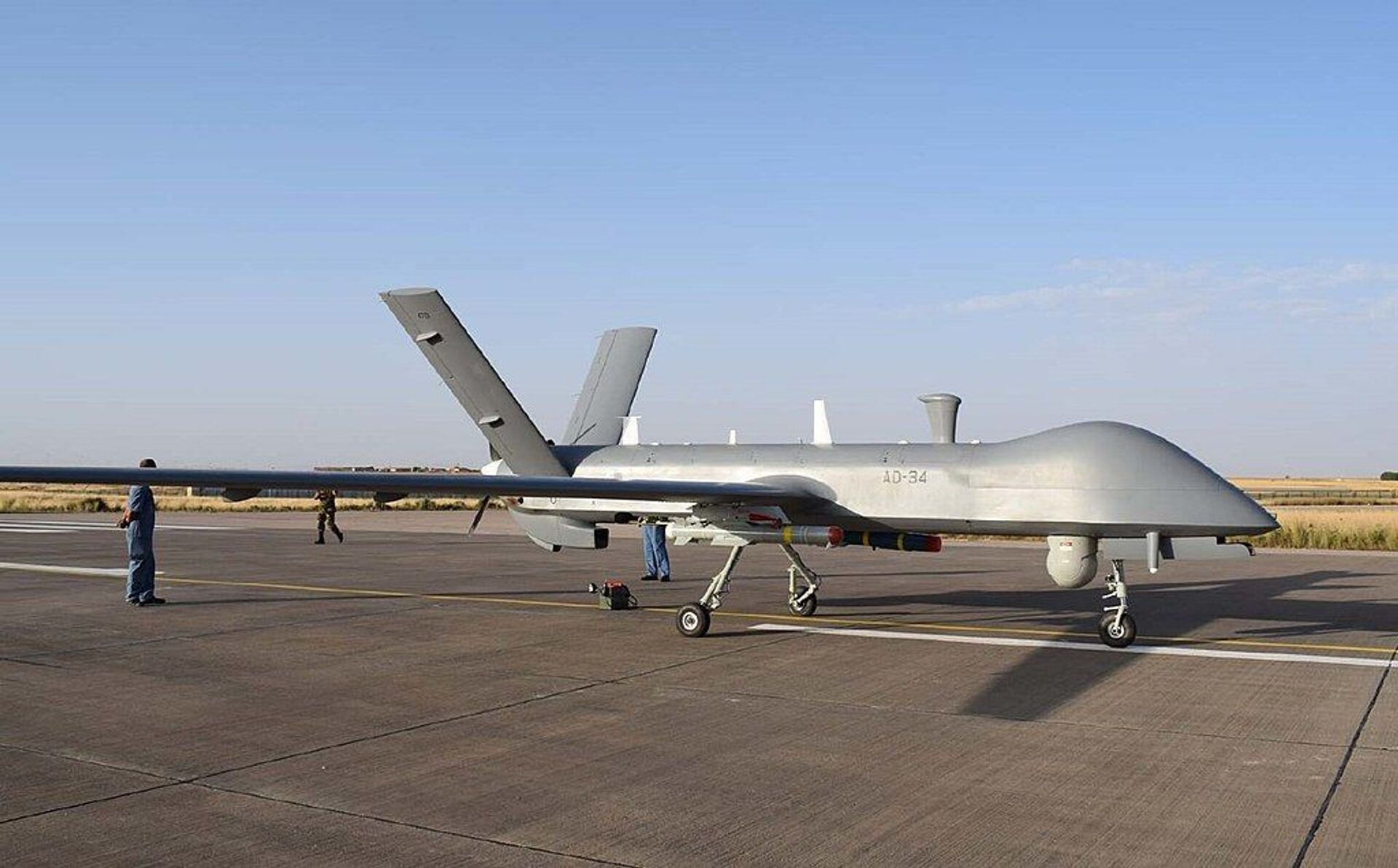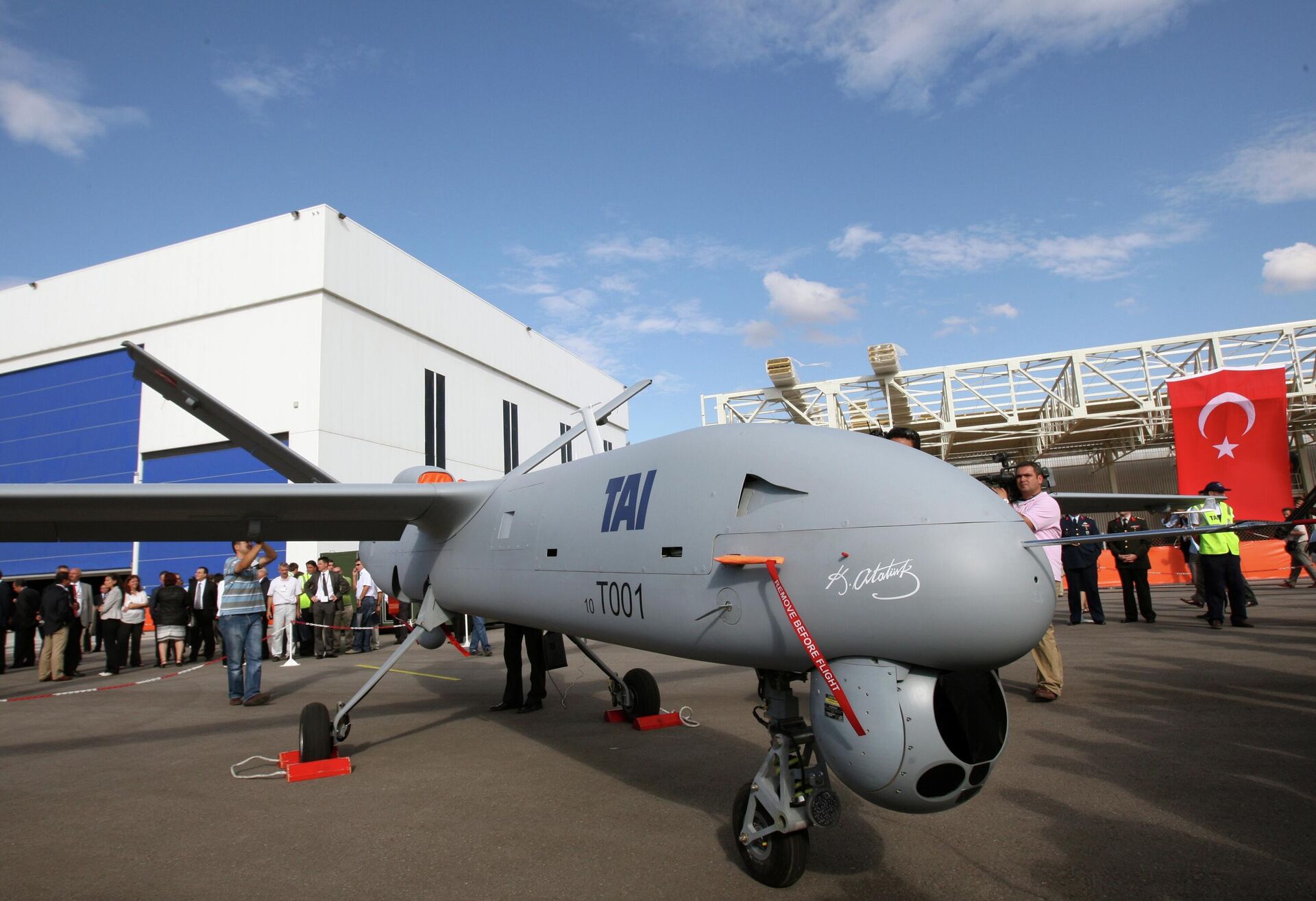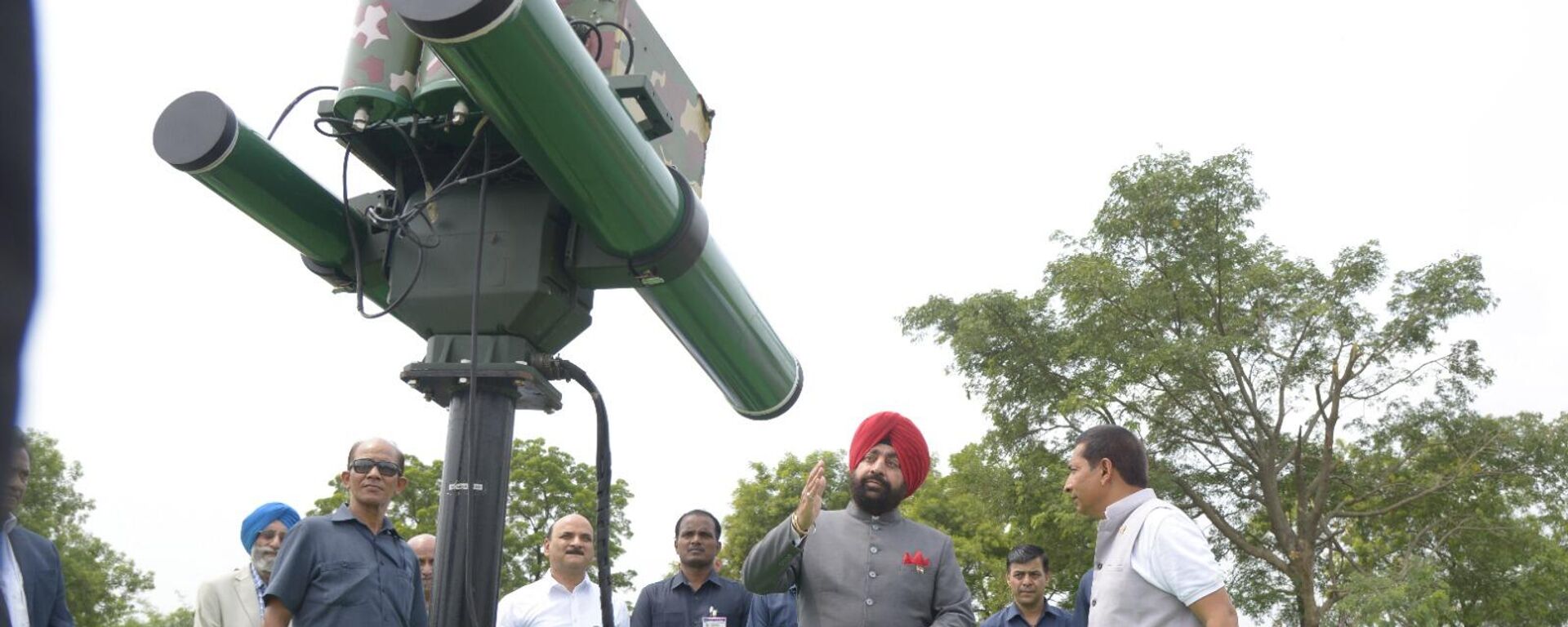https://sputniknews.in/20230907/skys-the-limit-whats-driving-demand-for-combat-drones-in-india-4088270.html
Sky's the Limit: What's Driving Demand for Combat Drones in India?
Sky's the Limit: What's Driving Demand for Combat Drones in India?
Sputnik India
With China's quantum leap in UAV technology and Pakistan's purchase of state-of-the-art drones from Turkiye, India does not want to be left behind by its neighbours in this race for cutting-edge unmanned aerial vehicles.
2023-09-07T15:08+0530
2023-09-07T15:08+0530
2023-09-07T15:44+0530
defenсe news
drone
kamikaze drone
reconnaissance drone
drone attack
kamikaze drones
nuclear-capable underwater drones
science & tech
india
china
https://cdn1.img.sputniknews.in/img/07e7/09/07/4097674_0:160:3072:1888_1920x0_80_0_0_3001a028e381b60731cbe6384b25225d.jpg
Drones have revolutionised military operations, providing enhanced surveillance capabilities, precise strikes, and the ability to operate in remote and dangerous environments.The Ukraine conflict has become a perfect example for this phenomenon. Since the onset of the military operation, Russia has pushed for developing state-of-the-art UAVs, like its famous kamikaze drones.As countries strive to strengthen their defence capabilities, the development and production of drones have become crucial factors in maintaining a competitive edge.India has emerged as a significant player in the global drone industry. With a growing demand for drone technology and a focus on self-reliance, India aims to establish itself as a leading drone manufacturer and exporter.Sputnik India explores the rise of India's indigenous drones, the potential of the Indian drone market, and the country's efforts to bridge the technological gap.Growing Demand for Drones in IndiaIndia, with its vast geographical expanse and diverse terrain, presents numerous opportunities for the use of drone technology. The country's defence forces recognize the value of drones in enhancing surveillance capabilities, border security, and counter-terrorism operations. Additionally, drones have found applications in agriculture, infrastructure development, disaster management, and various other sectors.The Indian drone market has witnessed significant growth in recent years. Chinese Drone Dominance: A Force to Be Reckoned WithChina, the world's leading exporter of military drones, has dominated the global drone market for the past decade. The Asian powerhouse has delivered 282 combat drones to 17 countries, as reported by the Stockholm International Peace Research Institute (SIPRI). Media reports indicate that countries like Saudi Arabia, Myanmar, Iraq, and Pakistan have used Chinese UAVs in their military operations.The PRC has emerged as a global leader in drone technology due to its commitment to research and development, state funding, and civil-military fusion. Between 2010 and 2020, China introduced a large number of combat drones capable of conducting precision strikes on enemy targets at a relatively low cost. Chinese drone manufacturers, such as DJI, have a significant market share in the small drone segment. DJI, based in Shenzhen, owns 70% of the market share in small UAV production. Its drones are widely used for various purposes, including agriculture, construction, security, emergency response, and defence.Indian Response: Investing in Technology and Self-RelianceRecognising the significance of drone technology in modern warfare, the Indian armed forces have invested heavily in various areas, including:These investments aim to enhance India's defence capabilities and bridge the technological gap with countries like China.In 2022, the Indian government imposed a ban on the nation's drone manufacturers from using Chinese components. This move was aimed at reducing dependence on Chinese technology and ensuring data security. While the ban may have initially posed challenges for Indian drone makers, it opened up new opportunities for the development of homegrown drone technologies and partnerships with non-Chinese countries.The Indian authorities have encouraged private players to contribute to the development of the drone industry. The Indian Air Force recently awarded a contract to a New Delhi-based start-up, Veda Defense System, for the production of 200 long-range swarm drones. This partnership between the Indian Air Force and a private player showcases the collaborative approach taken by the Indian armed forces to foster innovation and self-reliance.And off lately, Hyderabad has presented Indrajaal, India’s first AI-powered anti-drone system.Indian Armed Forces: Embracing Drone TechnologyThe Indian armed forces have demonstrated their capabilities in drone technology through various showcases and simulations. In January 2021, the Indian Army displayed its drone-swarming capability with 75 indigenously designed and developed drone-simulated offensive missions. Challenges for Indian Drone IndustryIndia faces challenges in dealing with asymmetric warfare, particularly in border areas where drones are used for smuggling arms, drugs, and counterfeit currency. The armed drone attack on the Jammu air base in 2021 underscored the security threats posed by UAVs. The increased cooperation between Pakistan and drone manufacturers from China and Turkiye has further heightened these concerns.The ban on Chinese components initially posed challenges for Indian drone makers, as finding an alternative supply chain can be costly and time-consuming. The ban on Chinese components highlighted the need for self-reliance in drone production. Indian armed forces and the commercial drone sector need to collaborate to develop critical components domestically. Bridging the Technological Gap: Focusing on Large DronesThe Indian drone industry is divided into two segments: small drone systems dominated by the private sector and larger drones developed by the public sector. While the private sector has made significant progress in small drone production, the development of larger drones, such as High Altitude Long Endurance (HALE) and Medium Altitude Long Endurance (MALE) drones, has faced challenges.HALE drones play a crucial role in the Indian armed forces' surveillance along the Indo-China border in eastern Ladakh. India has relied on Israeli drones to meet its HALE drone requirements. However, there is a growing need for indigenous HALE drones to ensure self-reliance and address security concerns. The Defence Research and Development Organization (DRDO) is working on the development of the Rustom-2 MALE UAV, which will soon undergo user trials.The indigenously developed TAPAS 201 UAV, also known as Rustom-2, has achieved significant milestones in terms of command-and-control capabilities. The successful demonstration of transferring control from a distant ground station to the warship INS Subhadra showcases India's progress in the development of MALE drones. The DRDO's efforts, coupled with collaborative efforts by domestic and international partners, are driving the advancement of large drones in India.In addition to surveillance capabilities, India is also focusing on the weaponisation of drones. The DRDO is leading a project for the arms integration of the Rustom UAV, which is in the final phase. This project aims to equip Indian drones with advanced weaponry, further enhancing India's defence capabilities.
https://sputniknews.in/20230906/how-does-indias-first-ai-powered-anti-drone-system-counter-drone-attacks-4068928.html
india
china
ukraine
russia
pakistan
Sputnik India
feedback.hindi@sputniknews.com
+74956456601
MIA „Rossiya Segodnya“
2023
Sputnik India
feedback.hindi@sputniknews.com
+74956456601
MIA „Rossiya Segodnya“
News
en_IN
Sputnik India
feedback.hindi@sputniknews.com
+74956456601
MIA „Rossiya Segodnya“
AI-Powered anti-drone system
Sputnik India
AI-Powered anti-drone system
2023-09-07T15:08+0530
true
PT2M07S
Sputnik India
feedback.hindi@sputniknews.com
+74956456601
MIA „Rossiya Segodnya“
india drones, indian drone industry, india drone technology, indian drones, indian drone market, chinese drone technology, indian air force, world's leading exporter of military drones, chinese drones, turkish drone, india’s first ai-powered anti-drone system, swarm drones, ai-powered anti drone system, inidan army using ai, ai technology in indian army, indian swarm drones, cutting edge technology india, kamikaze drones, drones in agriculture, iranian drones, cheapest drones, drones share price, best drones in india, drones in india, drones meaning in tamil, drones for delivery, agricultural dronesdrones for sale, drones for agriculture, agriculture drones,
india drones, indian drone industry, india drone technology, indian drones, indian drone market, chinese drone technology, indian air force, world's leading exporter of military drones, chinese drones, turkish drone, india’s first ai-powered anti-drone system, swarm drones, ai-powered anti drone system, inidan army using ai, ai technology in indian army, indian swarm drones, cutting edge technology india, kamikaze drones, drones in agriculture, iranian drones, cheapest drones, drones share price, best drones in india, drones in india, drones meaning in tamil, drones for delivery, agricultural dronesdrones for sale, drones for agriculture, agriculture drones,
Sky's the Limit: What's Driving Demand for Combat Drones in India?
15:08 07.09.2023 (Updated: 15:44 07.09.2023) With China's quantum leap in UAV technology and Pakistan's purchase of state-of-the-art drones from Turkiye, India does not want to be left behind by its neighbours in this race for cutting-edge unmanned aerial vehicles.
Drones have revolutionised military operations, providing enhanced surveillance capabilities, precise strikes, and the ability to operate in remote and dangerous environments.
The Ukraine conflict has become a perfect example for this phenomenon. Since the onset of the military operation, Russia has pushed for developing state-of-the-art UAVs, like its famous kamikaze drones.
As countries strive to strengthen their defence capabilities, the development and production of drones have become crucial factors in maintaining a competitive edge.
India has emerged as a significant player in the global drone industry. With a growing demand for drone technology and a focus on self-reliance, India aims to establish itself as a leading drone manufacturer and exporter.
Sputnik India explores the rise of India's indigenous drones, the potential of the Indian drone market, and the country's efforts to bridge the technological gap.
Growing Demand for Drones in India
India, with its vast geographical expanse and diverse terrain, presents numerous opportunities for the use of drone technology.
The country's defence forces recognize the value of drones in enhancing surveillance capabilities, border security, and counter-terrorism operations. Additionally, drones have found
applications in agriculture, infrastructure development, disaster management, and various other sectors.
The Indian drone market has witnessed significant growth in recent years.
According to a report by Research and Markets, the Indian drone market is projected to reach $1.21 billion by 2025, growing at a CAGR of 18.2% during the forecasted period.
Chinese Drone Dominance: A Force to Be Reckoned With
China, the world's leading exporter of military drones, has dominated the global drone market for the past decade.
The Asian powerhouse has delivered 282 combat drones to 17 countries, as reported by the Stockholm International Peace Research Institute (SIPRI). Media reports indicate that countries like Saudi Arabia, Myanmar, Iraq, and Pakistan have used Chinese UAVs in their military operations.
The PRC has emerged as a global leader in drone technology due to its commitment to research and development, state funding, and civil-military fusion. Between 2010 and 2020, China introduced a large number of combat drones capable of conducting precision strikes on enemy targets at a relatively low cost.
Chinese President Xi Jinping has described drones as capable of "profoundly changing war scenarios" and has pledged to accelerate the development of unmanned combat capabilities.
Chinese drone manufacturers, such as DJI, have a significant market share in the small drone segment. DJI, based in Shenzhen, owns 70% of the market share in small UAV production. Its drones are widely used for various purposes, including agriculture, construction, security, emergency response, and defence.
Indian Response: Investing in Technology and Self-Reliance
Focus on Artificial Intelligence and Autonomous Systems Recognising the significance of drone technology in modern warfare, the Indian armed forces have invested heavily in various areas, including:
These investments aim to enhance India's defence capabilities and bridge the technological gap with countries like China.
Ban on Chinese Component Imports In 2022, the Indian government imposed a ban on the nation's drone manufacturers from using Chinese components. This move was aimed at reducing dependence on Chinese technology and ensuring data security. While the ban may have initially posed challenges for Indian drone makers, it opened up new opportunities for the development of
homegrown drone technologies and partnerships with non-Chinese countries.
The Indian authorities have encouraged private players to contribute to the development of the drone industry. The Indian Air Force recently awarded a contract to a New Delhi-based start-up,
Veda Defense System, for the production of
200 long-range swarm drones. This partnership between the Indian Air Force and a private player showcases the collaborative approach taken by the Indian armed forces to foster innovation and self-reliance.
And off lately, Hyderabad has presented Indrajaal, India’s first AI-powered anti-drone system.
Indian Armed Forces: Embracing Drone Technology
The Indian armed forces have demonstrated their capabilities in drone technology through various showcases and simulations.
In January 2021, the Indian Army displayed its drone-swarming capability with 75 indigenously designed and developed drone-simulated offensive missions.
The partnership between the Indian Air Force and Veda Defense System signifies the willingness of the Indian military to embrace indigenous drone technologies. The contract awarded to Veda Defense System reflects the confidence placed in Indian private players to deliver advanced drone capabilities. It also highlights the growing synergy between the defence sector and the commercial drone industry.
Challenges for Indian Drone Industry
India faces challenges in
dealing with asymmetric warfare, particularly in border areas where drones are used for smuggling arms, drugs, and counterfeit currency.
The armed drone attack on the Jammu air base in 2021 underscored the security threats posed by UAVs. The increased cooperation between Pakistan and drone manufacturers from China and Turkiye has further heightened these concerns.
Search for Alternative Supplies The ban on Chinese components initially posed challenges for Indian drone makers, as finding an alternative supply chain can be costly and time-consuming.
The ban on Chinese components highlighted the need for self-reliance in drone production. Indian armed forces and the commercial drone sector need to collaborate to develop critical components domestically.
Bridging the Technological Gap: Focusing on Large Drones
The Division in the Indian Drone Industry The Indian drone industry is divided into two segments: small drone systems dominated by the private sector and larger drones developed by the public sector. While the private sector has made significant progress in small drone production, the development of larger drones, such as High Altitude Long Endurance (HALE) and Medium Altitude Long Endurance (MALE) drones, has faced challenges.
Focus on High Altitude Long Endurance (HALE) Drones HALE drones play a crucial role in the Indian armed forces' surveillance along the
Indo-China border in eastern Ladakh.
India has relied on Israeli drones to meet its HALE drone requirements.
However, there is a growing need for indigenous HALE drones to ensure self-reliance and address security concerns. The Defence Research and Development Organization (DRDO) is working on the development of the Rustom-2 MALE UAV, which will soon undergo user trials.
Development of MALE Drones in India The
indigenously developed TAPAS 201 UAV, also known as
Rustom-2, has achieved significant milestones in terms of command-and-control capabilities.
The successful demonstration of transferring control from a distant ground station to the warship INS Subhadra showcases India's progress in the development of MALE drones.
The DRDO's efforts, coupled with collaborative efforts by domestic and international partners, are driving the advancement of large drones in India.
Weaponization of Indian Drones In addition to surveillance capabilities, India is also focusing on the weaponisation of drones.
The DRDO is leading a project for the arms integration of the Rustom UAV, which is in the final phase. This project aims to equip Indian drones with advanced weaponry, further enhancing India's defence capabilities.





